

The Race Begins…The Johnny Dark Victress Is Given a “Once Over” by Duke Benson, Played by Actor Don Taylor in the 1954 Movie “Johnny Dark”
Note:
This is the first installment of a 3 part series of articles on the Johnny Dark Victress, Virgil Rice, Mack Hellings, Bob Stelling, the Hellings Company, and Stelling and Hellings. Here are links to the other parts of the story:
——————————–
Hi gang…
Hope you’re staying warm where you are. Florida is cold cold cold – in the 30’s last night. A bit too cold for me, but thank God for space heaters…(Florida houses are not insulated that well…)
Enough of the digression (just trying to warm up my fingers for typing…)
Rick and I have been tracking down noteworthy cars in each of the marques (Glasspar, Victress, etc) and one of my favorite cars from the 1950’s is the Victress S1 used in the 1954 movie, “Johnny Dark.” The year 1954 was an exciting time for Victress for many reasons which I’ll discuss below, and the use of a Victress S1 roadster in an “A Level” movie with Tony Curtis and Piper Laurie couldn’t have made Doc Boyce-Smith, Merrill Powell, Bill Quirk, and the rest of the folks at Victress (Richard Russell and later Mel Keys) more happy in any way.
But….before we discuss the specific car for our story, let’s learn a bit about Victress.
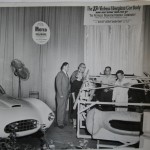
Here’s the Debut of Victress at the Petersen Motorama in November 1953. Shown are Doc Boyce-Smith and Bill Quirk Working Inside the Mold, and Ted Kelly (Glasses) Outside the Mold with Executives from the Celanese Corporation (Photo Courtesy of BJ Collections)
The Dawn of Victress
During our interviews with Merrill Powell, co-owner of Victress from 1954-1961 and Bill Quirk, Production Manager for Victress 1952-1961, we established that Victress started in mid to late 1952. The name of the company at the beginning was the “Boyce-Smith Company”, and this lasted from 1952 thru early 1954. During 1953 when Hellings built their Victress and the Guy Maybee Victress set a speed record, it would have been known as the “Boyce-Smith Company.” In early 1954 when Merrill Powell came on board as partner and co-owner of the company, Doc and Merrill changed the name to “Victress Manufacturing, Incorporated.” So by the time that the Johnny Dark movie was released in June 1954, their company was using their new business name – Victress Manufacturing, Incorporated.
Their first car was the Victress S1 body designed by Hugh Jorgensen and Doc Boyce-Smith. The next car to be released by Victress was the Victress S4 in early 1954 also designed by Hugh Jorgensen. The Victress S5 and dragster debuted in late 1954, and the Victress C2 and C3 coupes debuted in 1955. When you place this in the context of other fiberglass body manufacturers of the 1950’s, Victress proved themselves to be the most prolific in terms of designs and cars producing a greater number of designs, prototypes, and quantity of bodies than any other fiberglass manufacturer of the 1950’s.
Although the production records for the company no longer exist, we know that by November 1953, they had made their 27th Victress S1 body during the Petersen Motorama as a week long public exhibit in action. That is, day by day, entrants to the Motorama could watch a Victress body slowly being built. Bill Quirk tells me that part of the reason for the “slow” time frame was the limitations that the fire department put on them concerning the amount of resin and fiberglass they could use at one time. Think “flammable” gang.
The Motorama exhibit was great advertising for Victress, and Doc Boyce-Smith and Bill Quirk were there to complete their work and answer questions. They were even on KTLA, Los Angeles TV as well. To be a fly on the wall back then…what an experience that must have been.
Famous Moments in Victress History
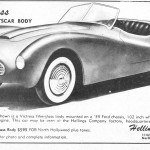
The First Mention of Victress That Rick and I Have Found Was in the July 31st 1953 Issue of Motor Sports World. It’s a Good Looking Drawing of a Very Special Car.
The first known advertising or mention of Victress found so far appeared in the July 31st, 1953 magazine Motor Sports World, and showed a Victress Sports Car built by Hellings. This occurred before the movie Johnny Dark had been filmed. The ad showed a drawing of a Victress built by Virgil Rice, General Manager of Hellings and stated:
“This car may be seen at the Hellings Company Factory, headquarters for the new Victress”.
Later that year, during the Bonneville Nationals in August 1953, Joe Mabee drove a Victress bodied race car over 200 mph for a 203.105 mph two-way average. This achievement led to the Victress becoming known as “The World’s Fastest Sports Car”. The coverage in magazines and newspapers of the time was monumental. Famed automotive builders Ray Brown and Denny Larson built this car, and thankfully this car exists today to be enjoyed by all.
In early 1954, Motor Trend released the most significant book on fiberglass cars produced in the 1950’s, and this was the Trend Book “The Manual of Building Plastic Cars”. Here the Victress S1 was showcased (Johnny Dark Victress) as well as other notable fiberglass marques across the country.
In addition, in late 1953, Victress released their first catalog (8 page) in booklet form as well as their book written by Doc Boyce-Smith and Ted Kelly (Allied Products Engineering Corporation) titled “How to Build a Fiberglass Car.”

Here Two Victress Employees Put the Finishing Touches on a Victress S1 Body – With Another S1 and an S4 Body Shown in the Background. Photo Courtesy of the Mel Keys Collection (Thanks Mel!)
Added to these facts is the previously mentioned November 1953 debut of Victress at the Petersen Motorama which showcased Victress and their work (Victress would later appear at the 1954 and 1955 Petersen Motoramas too.)
I mention these dates because it’s these events – along with the release of the movie Johnny Dark in June 1954, that set the wheels moving forward quickly for Victress, and contributed to their success, notoriety, and expansion.
Victress S1 vs S1A
It wasn’t until late 1953 after approximately 30 S1 bodies had been made that Victress made a change from the terminology “S1” to “S1A”. As Merrill Powell remembers…..
”It was to reduce the wheelbase from 102” to 99” to make it fit the recently released Frank Kurtis “Kurtis 500 KK” Chassis. It was a small change but an important change that we hoped to tie to increased sales”
So approximately 30 Victress S1 bodies were made using the 102 inch wheelbase configuration. This included the Helling’s Victress S1 as well as the Guy Mabee Special.
The Kurtis chassis was slightly shorter than a standard S1 body, and to help Victress make the change Frank Kurtis lent them a Kurtis KK500 chassis which they held onto while making the modifications (and at least one Victress S1 has been confirmed to have a Kurtis 500KK chassis.) Besides reducing the wheelbase, Victress also corrected side dimensions for wheel openings. It was common to have minor design / measurement imperfections during this era, and many of the cars, as you owners out there know, are not perfectly symmetrical – a testimony to the hand crafted nature of the bodies, molds, and each body and car built.
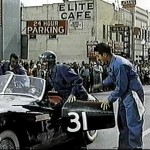
Here the Johnny Dark Victress aka the “Thunderbird” Driven by Duke Benson (Played by Don Taylor) Arrives in Reno Nevada, Mid-Race
So, from approximately the beginning of 1954 forward, Victress S1 bodies were no more, and the Victress S1A came into being. Taking proper measurements of the wheelbase of your Victress body can help establish an early build date vs a later one. That is, Victress S1 102” wheelbase bodies are dated from 1952-1953, and Victress S1A 99” wheelbase bodies are from 1954 to 1961. While the Victress bodies would be hand laid fiberglass, the later Vixen bodies (Victress S1A name under the LaDawri marquee from 1961-1965) would have been built using the fiberglass “chopper” gun. This added detail helps separate out Victress from LaDawri built bodies.
Car Craft: February 1954
Thankfully, much is known about the Johnny Dark Victress S1 roadster due to an article published in early 1954. Here’s what the article titled “Stude Sportster: Pretty Enough To Be A Movie Star” says about the Victress built by Virgil Rice, General Manager of Hellings Company:
“Pretty enough to be a movie star would be one way to describe Virgil Rice’s “streetliner.” The car was picked as one of the leading players in the upcoming Universal road racing picture “Johnny Dark,” and deservedly so……the car is one of the finest pieces of combination street and competition equipment that we’ve yet seen. To sum it up, the car is one of those rare machines that just plain feels good to drive. For smooth looks and useable performance we have yet to see a machine from across the pond that has it beat.”
Quite a statement of admiration for any car back in the day. I’m sure certain major manufacturers were jealous from the description. No doubt Virgil Rice was one proud owner/builder – especially having had his car used in what would become one of the major racing films of the mid 1950’s, and the most important sports car film to debut to date in 1954.
Let’s take a look at the article from ’54:
Summary:
I’ve scanned the full article for your review, as well as additional pictures below. Take the time to review the detail….I’m sure you’ll enjoy what you learn and read.
Hope you enjoyed the story gang so until next time..
Glass on….
Geoff
——————————————————————–
Click on the Images Below to View Larger Pictures
——————————————————————-
| Technical Specifications (From Car Craft, February 1954) | |
| Body |
|
| Designer |
|
| Body Work and Paint |
|
| Upholstery |
|
| Seats |
|
| Windshield / Glass |
|
| Hood / Doors / Trunk |
|
| Frame |
|
| Suspension |
|
| Front Axle |
|
| Rear Axle |
|
| Steering |
|
| Shocks |
|
| Driveshaft: (open/closed driveshaft) |
|
| Brakes |
|
| Engine (make/year) |
|
| Radiator |
|
| Speed Parts (heads, intake, cam, other): |
|
| Transmission (type/year) |
|
| Carburetion |
|
| Displacement |
|
| Horsepower (estimated) |
|
| Dashboard / Gauges |
|
| Steering Wheel |
|
| Wheelbase |
|
| Track/Tread (front/rear) (distance between center line of tires) |
|
| Wheels / Rims |
|
| Curb Weight |
|
| Top Speed (0-60) |
|
| Special Features |
|
- Here the Johnny Dark Victress aka “The Thunderbird” Driven by Duke Benson (Played by Don Taylor) Arrives in Reno Nevada, Mid-Race
- The Race Begins…The Johnny Dark Victress Is Given a “Once Over” by Duke Benson, Played by Actor Don Taylor in the 1954 Movie “Johnny Dark”
- Here’s the Debut of Victress at the Petersen Motoram in November 1953. Shown are Doc Boyce-Smith Working Inside the Mold, and Ted Kelly (Glasses) Outside the Mold with Executives from the Celanese Corporation
- The First Mention of Victress That Rick and I Have Found Was in the July 31st Issue of Motor Sports World. It’s a Handsome Picture of a Very Special Car.
- Here Two Victress Employees Put the Finishing Touches on a Victress S1 Body – With Another S1 and an S4 Body Shown in the Back. Photo Courtesy of the Mel Keys Collection (Thanks Mel!)
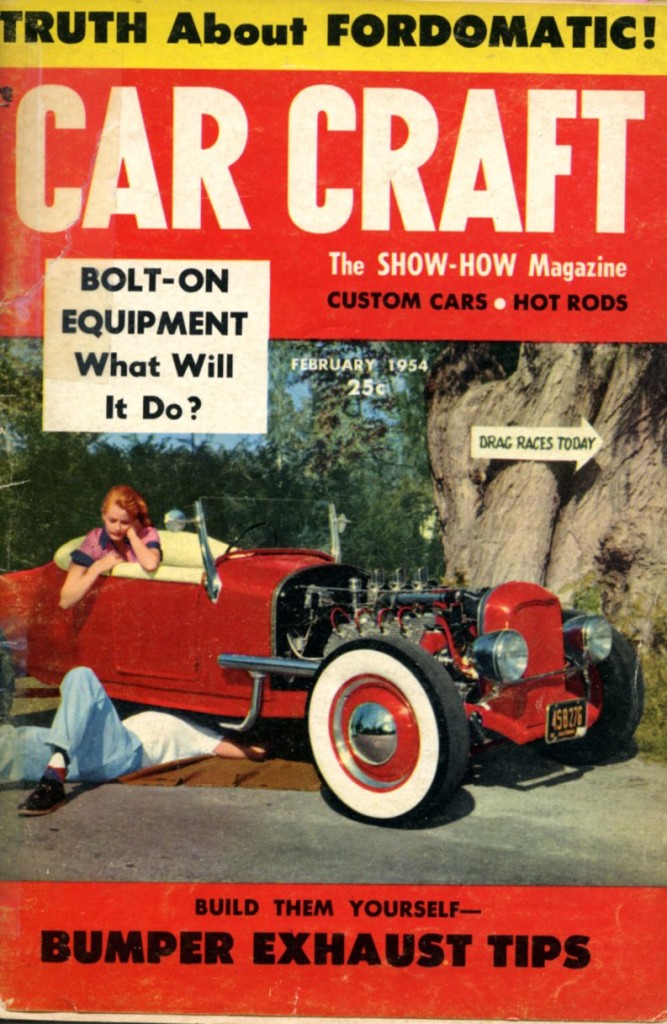
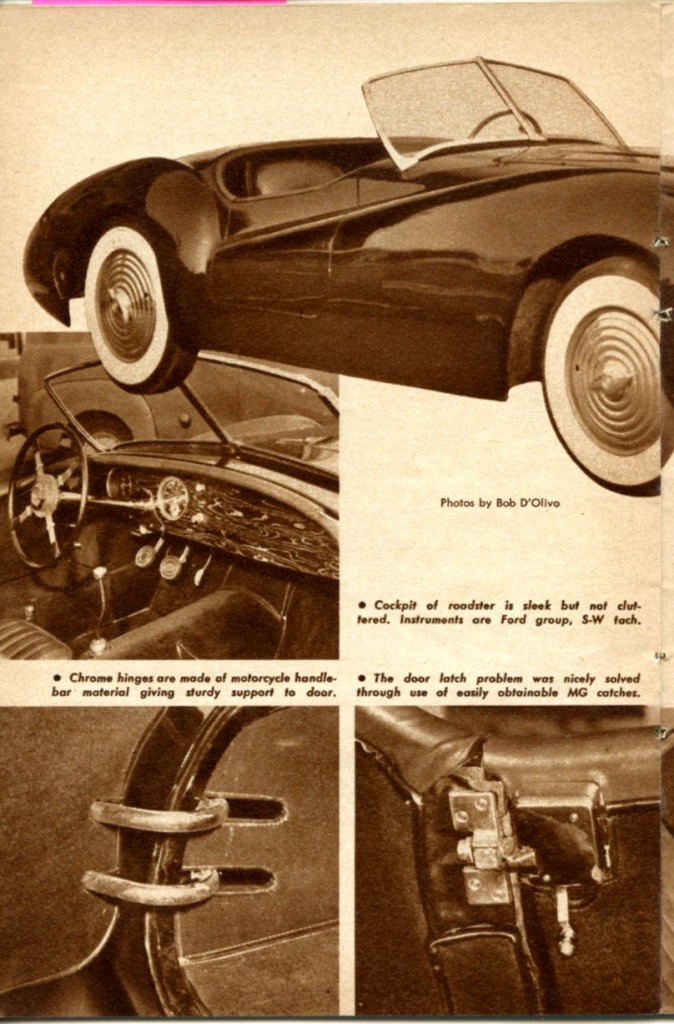
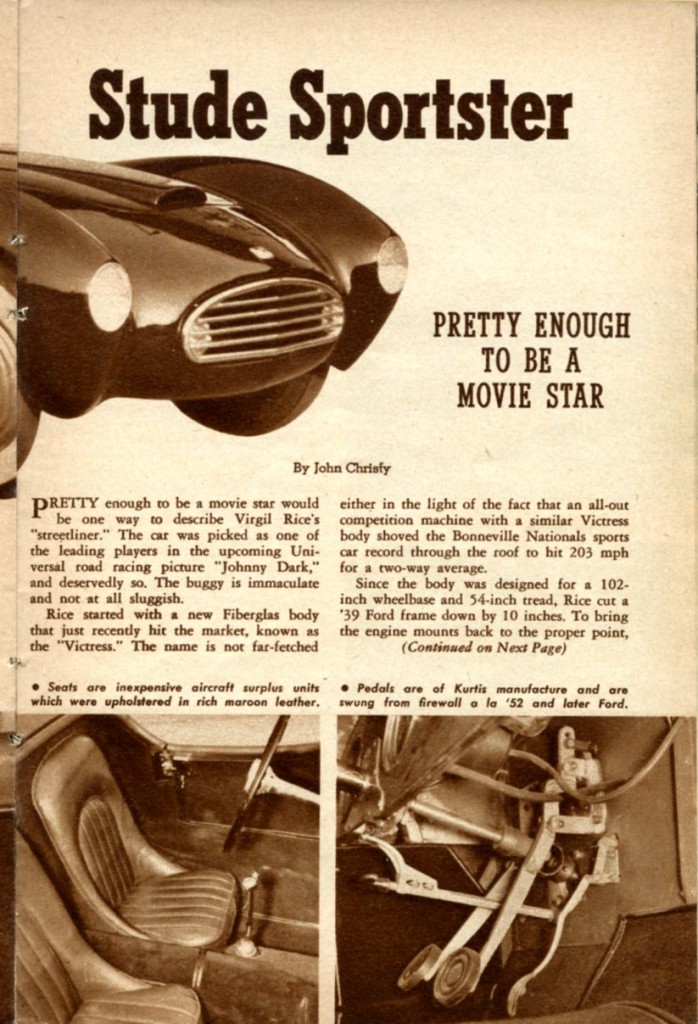
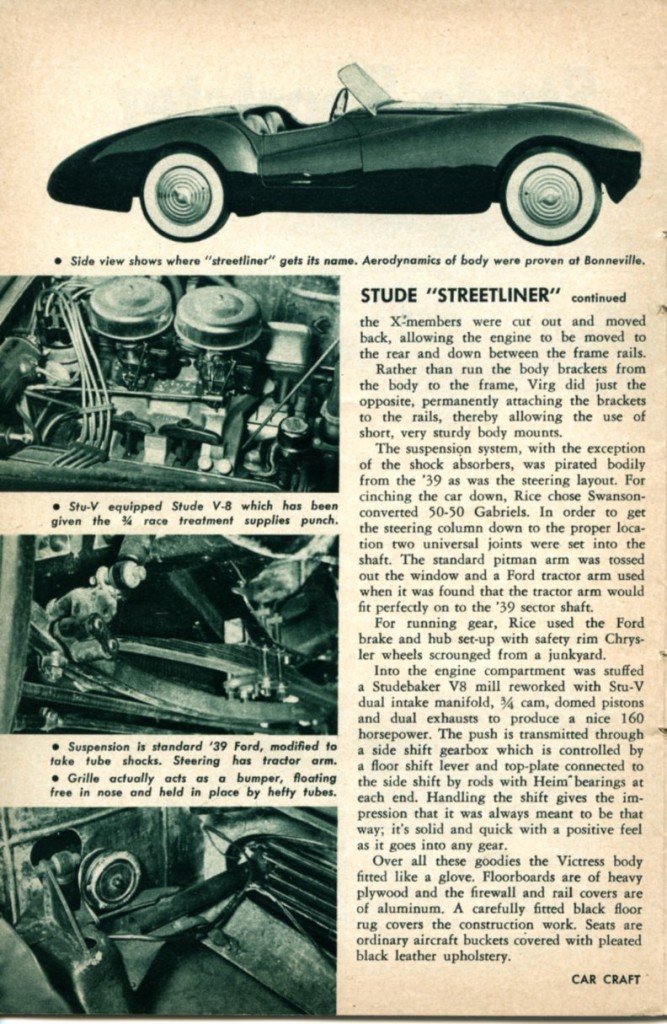
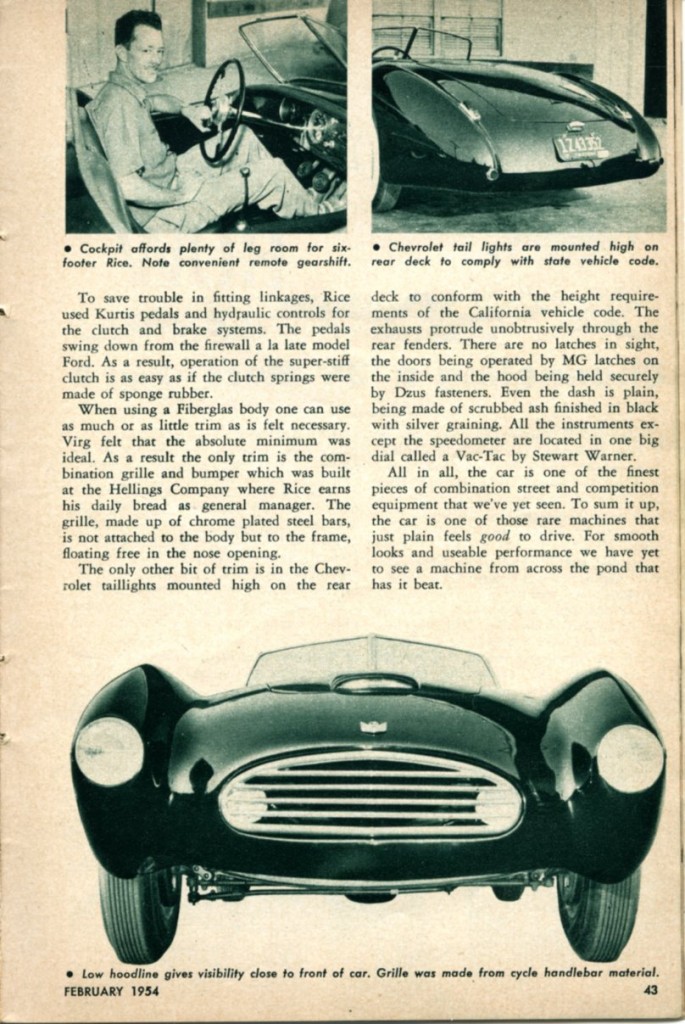

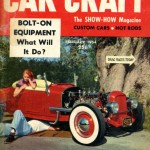
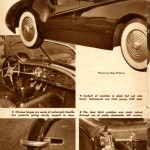








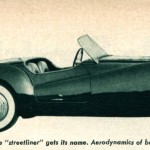
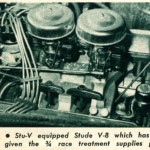


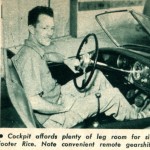
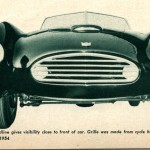
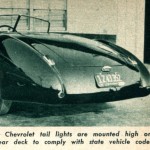
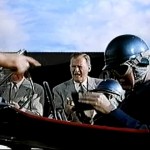

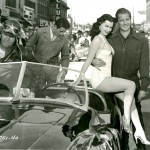
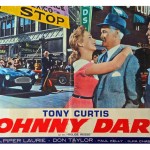
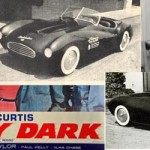
Among others, I owned a 1953 S1 in 1970/71. Have a couple of old Polaroids of the car in Costa Mesa, CA at the time. Not positive of its actual build number but identical to the “Thunderbird” in the movie. Did have the hardtop with the car. If interested contact me at the above email address